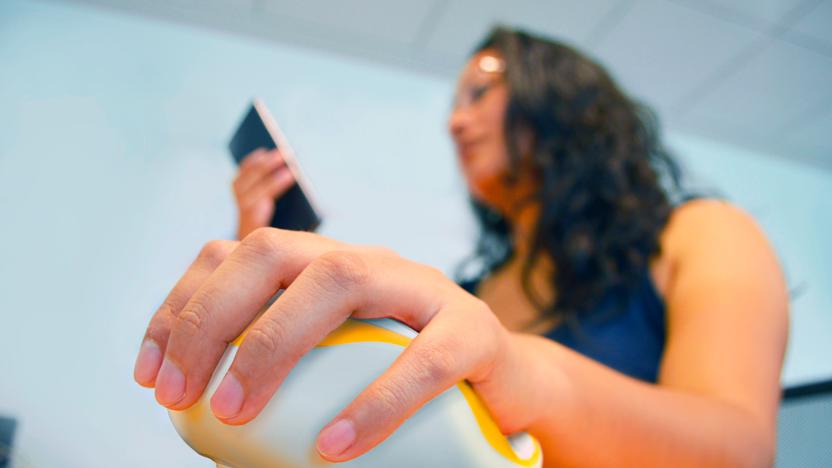HealthTech
Latest

FDA recalls close to half-a-million pacemakers over hacking fears
Turns out former Vice President (and erratic shooter) Dick Cheney was right all along: Your heart can be hacked. At least if you have a pacemaker, that is. On Tuesday, the FDA recalled 465,000 of the medical devices -- the ones that help control your heart beat -- citing security vulnerabilities. The pacemakers, which come from health company Abbott (formerly St. Jude Medical), require a firmware update. Fortunately, it can be installed by a health care provider in just three minutes. The models affected include the Accent, Anthem, Accent MRI, Accent ST, Assurity, and Allure.

A connected electrode could end the shame of sweaty palms
It's hard not to get sweaty walking around here at Computex in Taipei, but Tony Cueva Bravo had moist palms for another reason. The Peruvian entrepreneur suffers from hyperhidrosis, a condition that triggers excessive sweating, causing his hands to get frequently and uncomfortably moist. Hyperhidrosis can be off-putting and embarrassing, so Bravo did what any enterprising 24-year-old would do: He rounded up a team to find a fix and build a product to address it. Meet the Handrop, an orange-and-white potential game-changer that sits on your desk like a computer mouse.

Toshiba joins other tech giants in growing super-clean vegetables
The name "Toshiba" conjures images of stacks of laptops piled high and maybe the occasional television, but the Japanese electronics giant is turning its attention to something just a little more humble: lettuce. Well, spinach too. And swiss chard. Quartz's Dan Frommer tells the tale of a Toshiba-owned clean room nestled in the industrial corners of Yokosuka where people clad in special suits dutifully plant seeds and plop them on tall racks under an array of fluorescent lights. The end result? Tasty veggies that you won't need to wash (though if you're a mild hypochondriac like your author, you'd probably give 'em a quick rinse anyway).

Jawbone Up review
Back in July, Jawbone did something surprising. The company, best known for its Bluetooth headsets, announced it was cooking up a wristband called "Up" -- a wearable device that would track the wearer's sleeping, eating and exercise habits. At the time, we didn't know much more than that, but given the company's expertise in wearable tech, we assumed it would at least have a Bluetooth radio, tying it together with all the other products Jawbone sells. As it turns out, the wristband doesn't sync your vitals wirelessly and for better or worse, it doesn't work quite the way we thought it would. To use the wristband, you'll need an iOS device -- no other platform is supported, and there isn't even a mobile website to which you can upload all your data. Then again, it does things other fitness trackers don't: it monitors when you're in deep or light sleep, so that it can wake you when you're just dozing. And because it's waterproof up to one meter and promises up to 10 days of battery life, it's low-maintenance enough that you can wear it every day, which could be key to making some healthy lifestyle changes. So how did Jawbone do, stepping so far outside its comfort zone? And should you consider this over identically priced fitness trackers such as the new Fitbit Ultra? Let's see. %Gallery-141101%

Fitbit Ultra review
Oh, hey, Fitbit. Nice to see you again. Although we thought the original fitness tracker did too little for a $100 gadget, enough people apparently begged to differ, as the the outfit just trotted out a second-gen model, dubbed the Fitbit Ultra. Like its predecessor, this little guy analyzes eating, exercise and sleep patterns (largely with the help of an accompanying website). If you've been following along, you know that design hasn't changed much, while that website and hundred-buck price should be mighty familiar, too. This time around the company is adding a few new features, including Foursquare-esque badges and an altimeter for counting how many steps you've climbed. But does this series of minor enhancements add up to a significant improvement? Time to lace up your running shoes, kids, and meet us after the break. %Gallery-135129% %Gallery-135381%

Intel's Skoool software brings study materials to healthcare workers in developing countries
When we consider Intel's contributions to developing nations, it's hard not to hone in on the 5 million-plus Classmate PCs it's shipped over the past four years. This time, at least, Intel is leaving the hardware part of the equation to the Lenovos and HPs of the world and focusing on the software instead. The company just announced the Skoool Healthcare Education platform, a collection of online and offline educational materials designed to help healthcare workers in developing countries better treat women and children, tackling malnutrition, vaccination, communicable diseases and childbirth safety. To be clear, Intel isn't getting into the medical content business -- it didn't write these resources but instead culled them from various third-party sources. The idea is that the company will provide the platform to governments and healthcare workers for free, forgoing what might otherwise be an opportunity to collect licensing fees. (It'll be up to local governments to work with companies like Dell to secure low-cost PCs to run the software.) For now, Intel's launching the program in Sri Lanka, where it already has a working history with the President and Minister of Health, but a rep tells us the outfit hopes to expand the program to sub-Saharan Africa, Latin America, Central Eastern Europe and parts of Asia, reaching 1 million healthcare workers by the end of 2015. [Image courtesy of Intel]


